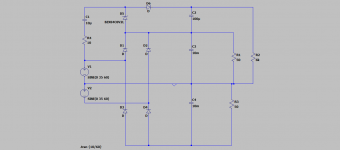Gauge is not very important. Winding over insulation has little effect (hair longer wire per turn and more ohms).
However the Volts/Turn on most popular size long-run transformers is 0.1V/T or less. So 10-15 turns is 1V or so, hardly worth it.
According to the "42 / [(outer_dia - inner_dia) * height/2] " formula I can get 1V for 2.58 turns.
42 / [(10-5)*6.5/2] = 2.58 turns per 1V
So, I can get extra 6V for approx 15 turns. Look of transformer suggest that this is a viable number because there isn't too much winding for existing 22v secondaries.
Btw, my concern is not related with winding count. My concern is side effects of patch soldering point inside winding.
Usually there are better alternatives. This circuit uses a small AC capacitor to drop the main secondary voltage without generating a lot of heat. It's not isolated but usually that's not an issue. And there are alternatives such as using a phone charger (cheap).
Attachments
Usually there are better alternatives. This circuit uses a small AC capacitor to drop the main secondary voltage without generating a lot of heat. It's not isolated but usually that's not an issue. And there are alternatives such as using a phone charger (cheap).
Thank you for circuit. I'm trying to increase secondaries about 6.5 volts in order to get 28.5V AC from 22V transformer.
22V AC is actually good for 4 ohms speakers but I have 8 ohms speakers.
I've done this once a long time ago, with regular insulated stranded wire, not proper enameled solid wire, but I've forgotten the voltage/turns it yielded.
I'm surprised the calculation suggests you get as much as 2.6V per turn, but you should still wind on more if you need it. Try winding on 12 inches of cheap wire to confirm the real V/turn.
I'm surprised the calculation suggests you get as much as 2.6V per turn, but you should still wind on more if you need it. Try winding on 12 inches of cheap wire to confirm the real V/turn.
I've done this once a long time ago, with regular insulated stranded wire, not proper enameled solid wire, but I've forgotten the voltage/turns it yielded.
I'm surprised the calculation suggests you get as much as 2.6V per turn, but you should still wind on more if you need it. Try winding on 12 inches of cheap wire to confirm the real V/turn.
No, it is 2.6 turns per volt. Yes, I would confirm the calculation with regular wire before real work of course.
I have added extra centre tapped turns with enameled wire over the top of the existing insulation, without issue. Both to increase or decrease the secondary. Have even done this with an EI transformer that had just enough space for the extra wire.
The trick is to measure the volts per turn first, calculate the required length of wire and then wind it as tightly as possible.
The trick is to measure the volts per turn first, calculate the required length of wire and then wind it as tightly as possible.
Regular insulated solid core wire works if you don’t need a lot of turns (volts) or a lot of current. I often use #14 THHN since it’s cheap and I keep it on hand. If you use magnet wire you really need to use some sort of outer tape on the windings to prevent shorts.
What size do you need? #22 is good for 1 amp in transformer applications. Every three gauges (including odd #’s) doubles the current capacity. They work like dB.
To calculate turns per volt just put on 10 temporary turns and measure the voltage. And the length.
What size do you need? #22 is good for 1 amp in transformer applications. Every three gauges (including odd #’s) doubles the current capacity. They work like dB.
To calculate turns per volt just put on 10 temporary turns and measure the voltage. And the length.
- Status
- This old topic is closed. If you want to reopen this topic, contact a moderator using the "Report Post" button.
- Home
- Amplifiers
- Power Supplies
- Patching secondary winding for more voltages?
